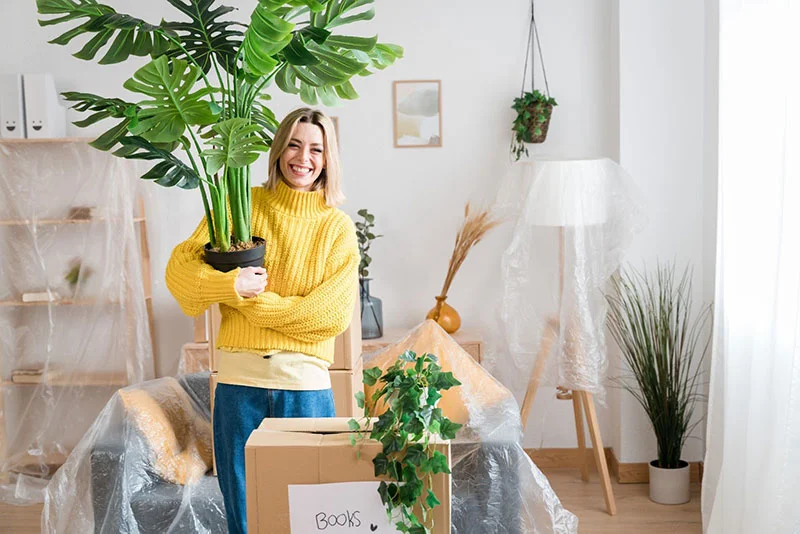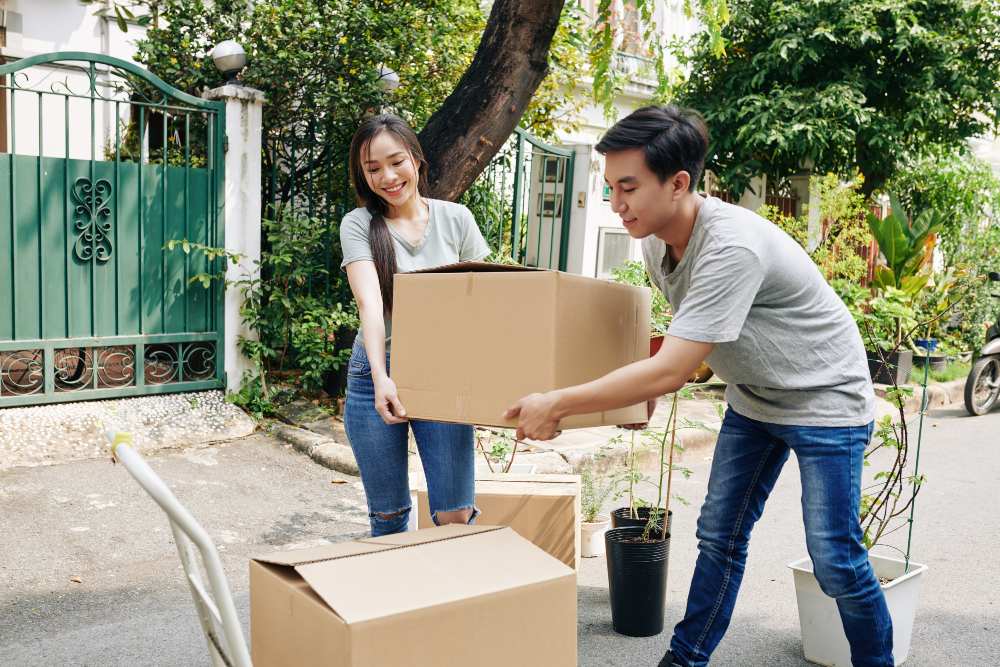How To Move Plants When Moving House
Plant lovers often want to take their beloved greenery with them when relocating. It’s a challenging feat, though, particularly if you’re a green thumb inexperienced in plant-moving antics. Trust us.
From selecting the proper method of transportation to packing and unpacking your plants, several factors must be considered to ensure a successful move. But don’t worry – with the proper steps, you can relocate your leafy friends without any worry.
In this comprehensive guide, we’ll give you detailed instructions to successfully transport your beloved greenery without a glitch, reassuring you that it’ll arrive in tip-top condition at your new home.
How to Prepare Your Plants for the Move
Time the Move
First things first, you need to decide when you want to start moving plants. Be sure to plan your relocation during the spring or Autumn months when the weather is mild and not too hot for your leafy buddies to transition.
On the other hand, extremely hot or cold temperatures can damage your plants, so avoid moving them during the summer or winter.
Water and Fertilise Your Plants
Start preparing your plants by watering them adequately a few weeks before your move. You don’t want to shift them when their soil is too wet or dry, so they’ll need time to settle before they head out on the big journey.
You can also fertilise your plants with balanced plant food at least two weeks before moving day to give them a much-needed nutrient boost to help them cope with the move, ensuring optimum plant health!
Prune Your Plants
Pruning is essential in preparing when moving plants to your new house or business. It reduces their overall size and weight, making them easier to transport. Plus, they look much nicer in your new home, too, so it’s a win-win.
To do this, cut back dead leaves, damaged or diseased leaves and stems, and remove any flowers or fruits to reduce their stress level during the move.
Treat Any Pests or Diseases
Before moving your plants, check them thoroughly for any pests or diseases. If you spot any infestations or diseases, treat them first before the big day. You can use natural remedies like neem oil or insecticidal soap to eliminate pests.
For fungal infections, use a fungicide and isolate the diseased plant to prevent spreading to other plants.
The Right Transportation Method For Moving Plants
Option 1: Self-Transportation
Self-transporting your plants is often the quickest and cheapest option, but there are drawbacks.
While you have complete control over the moving process and can pack the plants according to your liking, this option also requires a lot of preparation and equipment.
Here are a few more considerations to keep in mind:
- It requires significant equipment, such as moving boxes, packing materials, and a vehicle large enough to transport your plants.
- Long distances can be especially difficult as they may require multiple trips.
- You may damage or break your plants if you haven’t carefully considered how much space you need in your vehicle.
- If you have delicate plants that require extra care, hiring professional plant movers like Vmove can ensure they receive the special attention they need during the move.
Option 2: Hiring Professional Plant Movers
Hiring a removalist is another option to consider, especially if you’re moving interstate. We have specialised knowledge, equipment, and skills to provide your plants with a safe and secure journey. You can even direct us on where to place your plants once we’ve arrived at your new home so they’re immediately placed where you need them.
How To Pack When Moving Plants

Materials Needed for Packing Your Plants for the Move
1. Proper-Sized Pots or Containers
Before you start packing when moving plants, you should choose pots or plastic pots that are one to two inches larger in diameter than the root ball. The new pot should also have suitable drainage holes for adequate air circulation and to prevent waterlogging during transportation.
2. Soil for Your Pot Plants
You’ll need fresh potting soil to help your plants establish themselves in their new pots. We recommend using high-quality organic potting soil containing the necessary nutrients for your plants.
3. Packing Materials
You’ll also need various packing materials, such as packing paper, bubble wrap, and packing peanuts, to ensure your plants’ safety during transportation.
Make sure you wrap each plant’s pot tightly with any packing material to prevent soil from spilling. Then, fill the gaps between pots or containers with packing peanuts to prevent them from moving around or knocking into each other during the move.
4. Boxes
Once you’ve wrapped and padded your plants, it’s time to place them in appropriate-sized boxes. Choose sturdy, corrugated cardboard boxes that are at least 6 inches larger in diameter than your pots. Ensure that your cardboard or plastic moving boxes aren’t stacked on top of each other in a way that could damage your plants. Cut out handles on the sides of the boxes to make lifting and moving easier.
Tip: If you need moving boxes, Vmove can supply them for you.
5. Pot Plant Labels
Label each box with the plant’s name, care instructions, and a “live plant” label. It will help the movers handle them with more care and place them in the proper location in the moving truck.
How to Pack Different Types of Plants
Small Potted Plants
Plants in smaller pots are probably the easiest to pack, so place each one in a plastic bag and tie the top to prevent soil and extra water from spilling during transit.
Then, place the bagged plants in a sturdy box and fill any gaps with packing peanuts or newspaper for extra protection. Label the box ‘Fragile’ and ‘This Side Up’ so anyone handling the box will know how to handle it.
Larger Plants
Packing large pot plants can be tricky, but it’s doable with some planning.
First, root prune the plant to reduce its size. Then, choose a pot larger than the root ball and fill it with soil.
For larger plants like a fiddle leaf fig, carefully lift the plant and slip it into its original pot. Place the plant, with the root ball intact, into the new pot and fill any gaps with soil.
Finally, water the plant and allow it to sit for a few days before moving it to let any shock from re-potting subside.
Hanging Plants
Hanging plants require a little extra care when packing compared to potted ones. Remove it from its hanging pot to avoid damage to the plant, and wrap it gently in newspaper or bubble wrap. Secure the wrapping itself with tape or rubber bands.
Then, place the wrapped plant in a box and fill any gaps with packing peanuts or newspaper. Label the box ‘Fragile’ and ‘This Side Up’ – like you did before.
Outdoor Plants
Outdoor plants need a lot of care when packed up for a move. If possible, avoid uprooting them altogether. Instead, dig a trench around the plant, leaving as much soil intact as possible.
Once the plant is free from the ground, wrap the root ball with a burlap sack or sturdy fabric, securing it with twine.
Water the plant generously and cover it with plastic sheeting to moisten the soil during transit. For added protection, you can wrap a blanket or towel around the plant before tucking it into a sturdy box.
Tips and Best Practices for Moving Plants

Complying with Australian Quarantine Laws When Moving Plants
Relocating plants isn’t just about preparation and safe transportation; adhering to Australian state quarantine regulations is also essential. These laws protect our unique environments from harmful pests, diseases, and non-native species.
Each state has distinct rules, with some, like South Australia and Queensland, known for stringent inspections. Thus, before moving, particularly interstate, familiarise yourself with the quarantine laws of your destination state. The Australian Interstate Quarantine website offers comprehensive guides to assist you in planning your plant more effectively.
See Australian Government Regulations Here: LINK
Safety Precautions:
Before transporting your plants, consider the following safety tips:
- Avoid transporting plants in direct sunlight or during extreme temperatures (both hot and cold).
- Trim any branches or leaves of larger plants that may obstruct your view while driving.
- Secure plants in their pots and cover them with plastic bags or a newspaper to prevent soil from spilling.
- Label boxes or containers of plants to avoid confusion.
- Pack plants in your vehicle’s trunk or secure them so they don’t obstruct your driving vision.
Preparing Your Vehicle for Transport:
To make sure your plants arrive at their new location safely, take the following precautions:
- Remove any items that may damage them during transportation.
- Vacuum your vehicle’s interior to prevent soil from getting trapped in your car.
- Line the trunk or cargo area with plastic bags to avoid soil spills.
- Ensure your vehicle’s temperature is ideal for plant transportation.
Loading and Unloading Plants:
When loading and unloading when you are moving and packing plants to your new home or office, follow these best practices:
- Transport plants in a covered vehicle or secure them under a tarp to protect them from wind or debris.
- Use a dolly or handcart to move large plants.
- Lift plants from their pots instead of pulling them by their stems.
- Unload them before sunset to prevent wilting.
Key Takeaways For Moving Plants
How To Move Plants When Moving House: The Right Way!
Moving plants the easy way just takes a bit of planning, patience, and care.
Whether moving a single plant or several, using the methods suggested in this blog post, you can safely and securely move your leafy friends to your new garden with minimal stress.
Remember that some states have regulations on bringing plants across state lines, so always check the laws before you plan your move.
Need more support for moving plants in your new home or business?
Moving your plant babies can be challenging, but with the right steps, you can relocate your leafy friends without worry.
Vmove are trusted Sydney removalists, and we’re a friendly team with a proven track record dedicated to helping our valued customers have the best possible experience.
We offer a wide range of furniture removalists services & local removalists solutions to suit every need, and our team is highly experienced and professional. We’ll work with you to ensure your move goes smoothly and do everything we can to make it as hassle-free as possible.
Please Note:
For the safety and well-being of your plants, we do not transport wet plants, particularly those exposed to rain or excessive moisture. This is because transporting wet plants can lead to potential damage and compromise their health during transit. Our commitment to providing a reliable and professional service ensures that we prioritise the care and protection of your plants throughout the moving process.
Contact us today to learn more about our services and to get a tailored quote.








